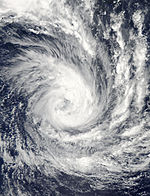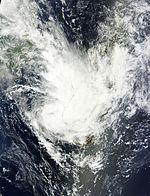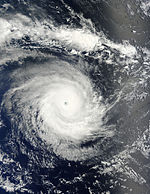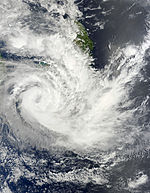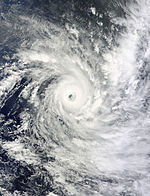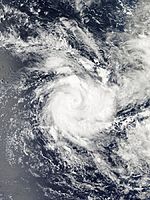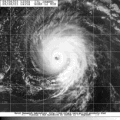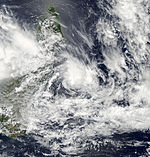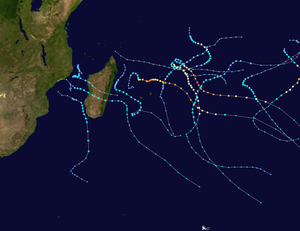a hot rock mantis production
your guide to the climate of Réunion Island
Ile de la Réunion
The original and most informative
English language guide to the island

Cyclones
a breath of fresh air
Reunion Island lies in the Southwest
Indian Ocean Basin. The cyclone season is, officially,
from November 15th 2014 to April 30th 2015 - with the
exception for Mauritius and the Seychelles, for which it
will end on May 15, 2015.. There are, on average, 10.4
cyclones per season accounting for 12%
of the Earth's total. Of these an average of 4.4
are categorised as severe.
Names for cyclones 2014 - 2015
beginning 15/11/14 and ending 30/04/15- Tropical storm
are only named once they have reached the stage of
"moderate tropical storm". Names are assigned by
Sub-regional Tropical Cyclone Advisory Centre in
Madagascar (for west of 55°E) or Mauritius (for
55°-90°E). A new annual list is used every year. Those
barred have been and gone, if coloured click for link.
Adjali Bansi Chedz
Diamondra Eunice Fundi Glenda Haliba Ikola Joalane Kesha
Lugenda Mahara Nathan Oscar Puleng Quenelle
Roselina Sitara Tarik Umali Vuntu Wezi Xolani Yolande
Zita
Current cyclone status - green- good, slightly yellow - be vigilant, orange - not so good, red - oh shit!
click for definition of status
A general introduction
A tropical cyclone is a type of
low-pressure system which generally forms in the
tropics. While some, particularly those that make
landfall in populated areas, are regarded as highly
destructive, tropical cyclones are an important
part of the atmospheric circulation system, which
moves heat from the equatorial region toward the
higher latitudes.
Global air conditioning
Structurally, a tropical cyclone is a
large, rotating area of clouds, wind, and thunderstorm
activity. The primary energy source of a tropical
cyclone is the release of heat of condensation from
water vapor condensing at high altitudes. Because of
this, a tropical cyclone can be thought of as a giant
vertical heat engine.
The ingredients for a tropical cyclone include a
pre-existing weather disturbance, warm tropical oceans
(+-26° C surface temp), moisture, and relatively light
winds aloft. If the right conditions persist long
enough, they can combine to produce the violent winds,
incredible waves, torrential rains, and floods
associated with this phenomenon.
This use of condensation as a driving force is the
primary difference setting tropical cyclones apart from
other meteorological phenomena, such as mid-latitude
cyclones, which draw energy mostly from pre-existing
temperature gradients in the atmosphere. To drive its
heat engine, a tropical cyclone must stay over warm
water, which provides the atmospheric moisture needed.
The evaporation of this moisture is driven by the high
winds and reduced atmospheric pressure present in the
storm, resulting in a sustaining cycle.
The terms "hurricane" and "typhoon" are regionally specific names for a strong "tropical cyclone" . A tropical cyclone is the generic term for a non-frontal synoptic scale low-pressure system over tropical or sub-tropical waters with organized convection (i.e. thunderstorm activity) and definite cyclonic surface wind circulation..
Tropical cyclones with maximum sustained surface winds of less than 17 m/s (34 kt, 39 mph) are called "tropical depressions". Once the tropical cyclone reaches winds of at least 17 m/s (34 kt, 39 mph) they are typically called a "tropical storm" and assigned a name. If winds reach 33 m/s (64 kt, 74 mph)), then they are called:
- "hurricane" (the North Atlantic Ocean, the Northeast Pacific Ocean east of the dateline, or the South Pacific Ocean east of 160E)
- "typhoon" (the Northwest Pacific Ocean west of the dateline)
- "severe tropical cyclone" (the Southwest Pacific Ocean west of 160E or Southeast Indian Ocean east of 90E)
- "severe cyclonic storm" (the North Indian Ocean)
- "tropical cyclone" (the Southwest Indian Ocean)
Sources : AOML and Armaegeddon online
The last "real" cyclone to affect Reunion - Dina (in French)


